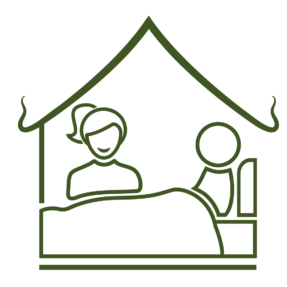Causes of incontinence in older people
Incontinence in older people is a common problem that can have various causes. Here are some of the main reasons:

- Muscle weakness:
- As we age, muscles, including the pelvic floor muscles, lose strength. This can result in the muscles no longer being able to effectively control the flow of urine.
2 Neurological disorders:
- Conditions such as Parkinson’s disease, stroke, multiple sclerosis or dementia can affect the nerves that control bladder function, leading to incontinence.
3 Chronic diseases:
- Diabetes and other chronic diseases can affect bladder function and lead to incontinence.
4 Urinary tract infections (UTIs):
- UTIs can irritate the bladder and lead to temporary incontinence.
5 Medication:
- Some medications, such as diuretics, can cause incontinence as a side effect.
6 Prostate problems:
- In older men, prostate conditions, such as an enlarged prostate or prostate cancer, can lead to incontinence.
7 Hormonal changes:
- Especially in post-menopausal women, hormonal changes can affect bladder function.
8 Movement and mobility problems:
- Difficulty walking or moving around can make it difficult for older people to get to the toilet in time.

Support options for carers
Carers play a crucial role in supporting older people with incontinence. Here are some approaches to help them:
- Promoting the pelvic floor muscles:
- Regular exercises to strengthen the pelvic floor muscles can improve bladder control.
2 Bladder training:
- Scheduled bladder training can help to improve bladder control. This includes fixed toilet times and gradually increasing the intervals between visits to the toilet.
3 Adjusting diet and fluid intake:
- Reducing caffeinated and alcoholic drinks can help to improve bladder control. Care should also be taken to ensure that sufficient, but not excessive, fluid intake is maintained.
4 Medication review:
- A medication review by a doctor can help minimise side effects that cause or worsen incontinence.
5 Use of aids:
- Incontinence products such as special pads, underwear or catheters can make everyday life easier and reduce the risk of skin irritation or infection.
6 Training and education:
- Carers and those affected should be informed and educated about incontinence and its management in order to provide the best possible care.
7 Environmental design:
- A barrier-free environment, including accessible toilets and the use of aids such as grab rails, can help prevent accidents.
8 Personal hygiene support:
- Regular and thorough cleaning of the skin can minimise the risk of infections and skin problems.
9 Psychological support:
- Incontinence can be emotionally distressing. Support through counselling and possibly psychological support can help to strengthen the self-esteem of those affected.

Leave a Reply